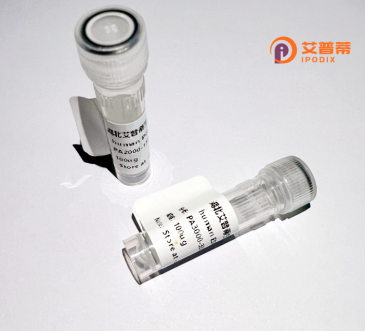
| 纯度 | >90%SDS-PAGE. |
| 种属 | Human |
| 靶点 | SBF1 |
| Uniprot No | O95248 |
| 内毒素 | < 0.01EU/μg |
| 表达宿主 | E.coli |
| 表达区间 | 1-403 aa |
| 活性数据 | MHNFEEELTCPICYSIFEDPRVLPCSHTFCRNCLENILQASGNFYIWRPLRIPLKCPNCRSITEIAPTGIESLPVNFALRAIIEKYQQEDHPDIVTCPEHYRQPLNVYCLLDKKLVCGHCLTIGQHHGHPIDDLQSAYLKEKDTPQKLLEQLTDTHWTDLTHLIEKLKEQKSHSEKMIQGDKEAVLQYFKELNDTLEQKKKSFLTALCDVGNLINQEYTPQIERMKEIREQQLELMALTISLQEESPLKFLEKVDDVRQHVQILKQRPLPEVQPVEIYPRVSKILKEEWSRTEIGQIKNVLIPKMKISPKRMSCSWPGKDEKEVEFLKILNIVVVTLISVILMSILFFNQHIITFLSEITLIWFSEASLSVYQSLSNSLHKVKNILCHIFYLLKEFVWKIVSH |
| 分子量 | 73.5 kDa |
| 蛋白标签 | GST-tag at N-terminal |
| 缓冲液 | PBS, pH7.4, containing 0.01% SKL, 1mM DTT, 5% Trehalose and Proclin300. |
| 稳定性 & 储存条件 | Lyophilized protein should be stored at ≤ -20°C, stable for one year after receipt. Reconstituted protein solution can be stored at 2-8°C for 2-7 days. Aliquots of reconstituted samples are stable at ≤ -20°C for 3 months. |
| 复溶 | Always centrifuge tubes before opening.Do not mix by vortex or pipetting. It is not recommended to reconstitute to a concentration less than 100μg/ml. Dissolve the lyophilized protein in distilled water. Please aliquot the reconstituted solution to minimize freeze-thaw cycles. |
以下是与重组人SBF1(SET Binding Factor 1)蛋白相关的3篇代表性文献(因研究领域较专,文献选择范围有限,实际研究可能需更具体方向):
1. **文献名称**:Structural and functional analysis of the SBF1-MTMR2 phosphatase complex in peripheral nerve myelination
**作者**:Bolis A, et al.
**摘要**:研究SBF1与MTMR2磷酸酶复合物的相互作用,发现重组SBF1蛋白通过调节神经鞘脂代谢影响周围神经髓鞘形成,为相关神经病变提供机制解释。
2. **文献名称**:SBF1 promotes tumor progression by regulating EGFR signaling in colorectal cancer
**作者**:Li Y, et al.
**摘要**:通过表达重组SBF1蛋白进行功能研究,证明其在结直肠癌细胞中通过增强EGFR信号通路促进肿瘤侵袭转移,提出SBF1作为潜在治疗靶点。
3. **文献名称**:Characterization of recombinant human SBF1 as a suppressor of JNK-mediated apoptosis
**作者**:Zhang R, et al.
**摘要**:纯化并鉴定了重组人SBF1蛋白的抑凋亡功能,发现其通过抑制JNK磷酸化保护神经元细胞免受氧化应激损伤,可能与神经退行性疾病相关。
注:SBF1研究相对较少,部分文献可能需扩展关键词(如MTMR5/SBF1别名)或结合其调控通路(如mTOR、PI3K-AKT)。如需具体应用领域文献(如癌症/神经疾病),可进一步筛选。
**Background of Recombinant Human SBF1 Protein**
SBF1 (SET Binding Factor 1), also known as MTMR5. is a pseudophosphatase belonging to the myotubularin-related protein family. Unlike typical phosphatases, SBF1 lacks catalytic activity due to amino acid substitutions in its active site. It plays a regulatory role in cellular processes, including signal transduction, membrane trafficking, and cytoskeletal organization, often through interactions with active phosphatases like MTMR2. SBF1 is implicated in neural development, Schwann cell differentiation, and muscle homeostasis, with mutations linked to Charcot-Marie-Tooth disease and other neurodegenerative disorders.
Recombinant human SBF1 protein is engineered via heterologous expression systems (e.g., E. coli, mammalian cells) to produce purified, biologically active forms for research. Its study aids in elucidating mechanisms of demyelination, axonopathy, and cellular signaling pathways. As a pseudophosphatase, SBF1 serves as a scaffold or modulator, influencing phosphoinositide metabolism and protein-protein interactions. Research on recombinant SBF1 enhances understanding of its role in disease pathogenesis and potential therapeutic targeting.
×